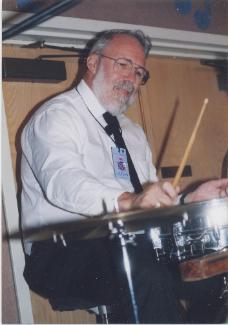(Lake LACD 339 – double album). Playing time: 56mins. 45secs.
Wolverine Blues; Driftwood; Lazy River; You Are Just a Vision; Dinah; Swanee; Stardust; I’d
Climb The Highest Mountain; Skylark; O Katharina!; That’s The Good Old Sunny South; Angry;
No One Knows What It’s All About; Hawaiian Butterfly; Mean To Me.
Recorded The Customs House, South Shields, England, Nov. 10, 2014
Personnel: Andy Schumm, cornet; Kristoffer Kompen, trombone; Mauro Porro, clarinet, alto
saxophone; David Boeddinghaus, piano; Frans Sjöström, bass saxophone; Josh Duffee, drums.
Among the many unrecorded early jazz and ragtime performers, two of the most celebrated are
Scott Joplin and Buddy Bolden. While Joplin’s playing was preserved on several piano rolls in
1916, these were edited so we can’t be sure of what Joplin actually played. A number of piano
players, Knocky Parker being one, have also tried to recreate his playing in recordings of his
compositions. As for Bolden, there is the legend of a wax cylinder recording of his band, but it
has not been unearthed to this day. Based on the statements of musicians who played with—or
at least heard—Bolden, Humphrey Lyttelton, for one, tried to recreate what Bolden must have
sounded like in a double LP titled Gonna Call My Children Home: The World of Buddy Bolden.
No such problem exists with Bix Beiderbecke; since a good number of recordings he made are
still available, we know what he sounded like. Not available, of course, are numbers he did not
record, and this CD attempts to supply that deficiency by recreating performances of some of
the tunes in his repertoire he did not record (or at least were unissued), as the title indicates,
and some he well may have played. While many cornetists, such as Johnny Wiggs and Jimmy
McPartland, were influenced by Beiderbecke, others, such as Richard Sudhalter and Tom
Pletcher, have attempted to copy the style and tone of Beiderbecke. None, however, has
captured the sound and the style—indeed the spirit—of Bix better than Andy Schumm does in
this session.
The group here follows the instrumentation of Bix and His Gang—cornet, clarinet, trombone,
piano, bass sax, drums. Half of the band is European—from Norway, Sweden, and Italy—the
rest from the U.S., but all blend together well, being intimately acquainted with Bix. Of the U.
S. contingent, Duffee on drums has impressive credentials, being a board member of the Bix
Beiderbecke Memorial Society as well as living in Davenport,. Iowa, and leading a vintage big
band. Boeddinghaus, formerly of New York, now of Louisiana, is a well-known pianist in
vintage jazz circles. Schumm is a 20s jazz specialist, particularly in Beiderbecke. The results of
his passion for Bix are manifest in this CD as he gets a fairly close approximation of Bix’s tone,
nicely executes the half-valve work, and captures the kind of breaks that Bix favored, each
seeming to leap out of the speakers affirmatively.
Quite a few tunes on the list will be less-than-familiar to most, I would imagine, and that is not
a bad thing. I was a bit surprised to see Hoagy Carmichael’s Skylark in there as it is of later
vintage than the others on the list. Hoagy and Bix were close friends and did play together on
at least one occasion, and of course Carmichael’s Stardust is included on this CD. However, the
CD insert tells that while Skylark was published in 1941 (some ten years after Bix’s demise), it
was actually composed several years earlier (its original title to have been Bix Licks) for a
musical about Bix. Having obtained the arrangement presented here from Swedish jazz
cornetist Bent Persson, the group thought it fitting to include in the program.
From the lively full-group rendition of Wolverine Blues that opens the recording to the
passionate piano/cornet duet on Mean to Me (which perhaps gives us a sense of what Bix might
have produced had overdubbing been more available in his time) that closes it, this CD will
delight Bix fans or those who are partial to 20s jazz. I should also add that the controlling idea
of having the tune list comprise unrecorded numbers that Bix did play or might have played
was a sound one. Why bother to copy and record tunes that were recorded by Bix himself and
were issued at the time, when these original recordings are still available? There would be little
originality there; but here we have something that is unique. Two thumbs up.
This CD is available on Amazon and elsewhere on line and also from Lake Records at http:
//www.fellside.com.
|
|



